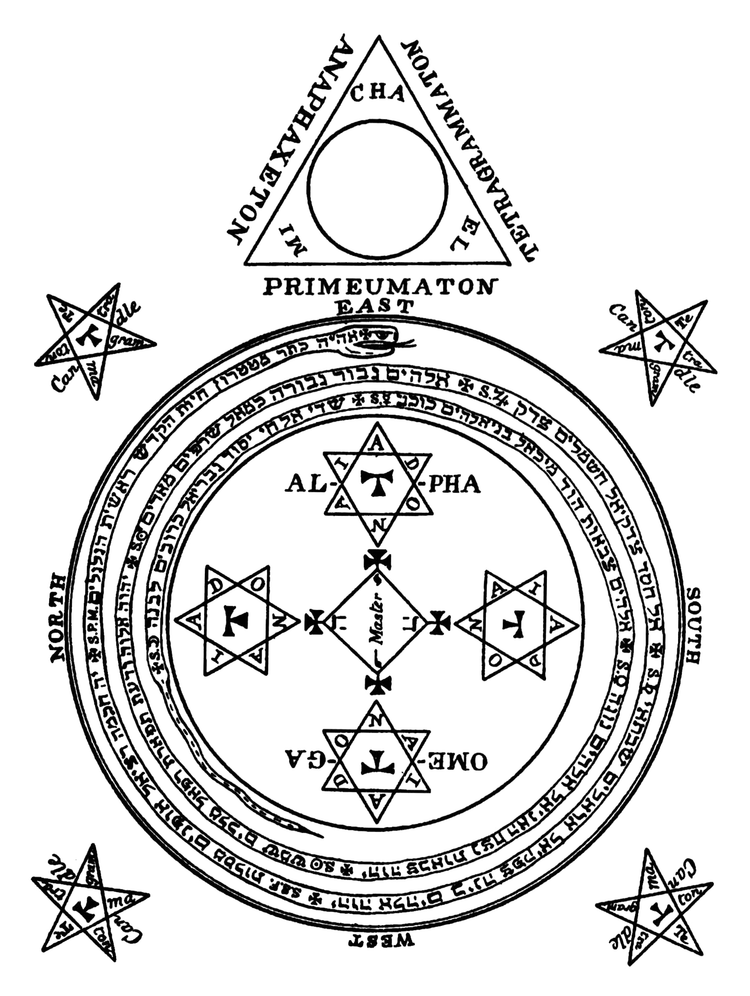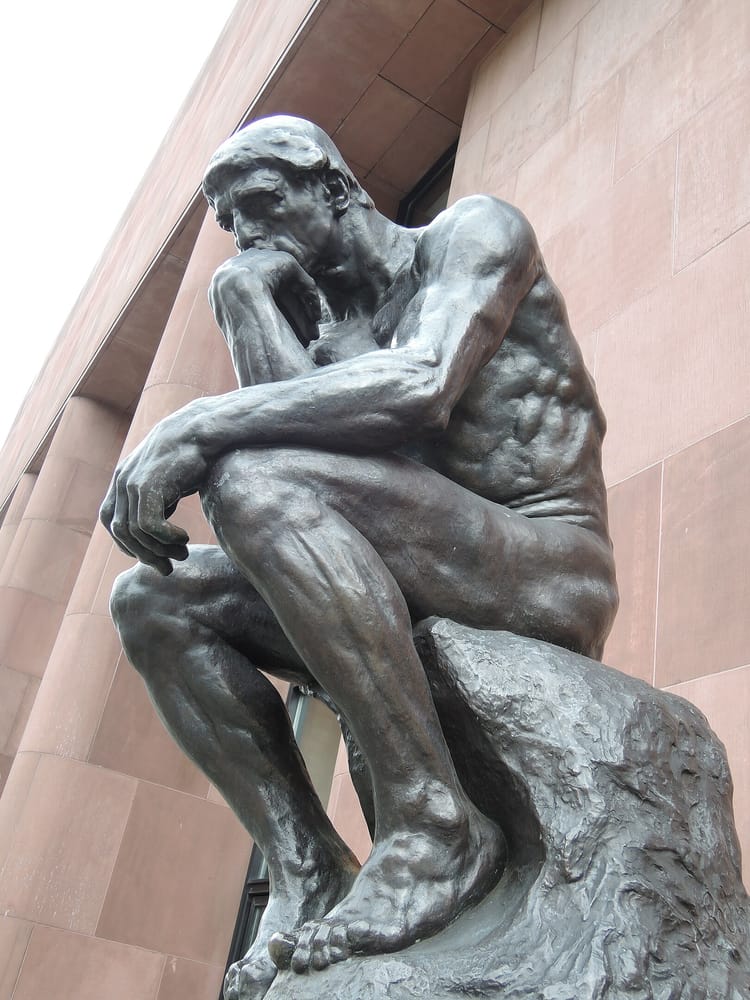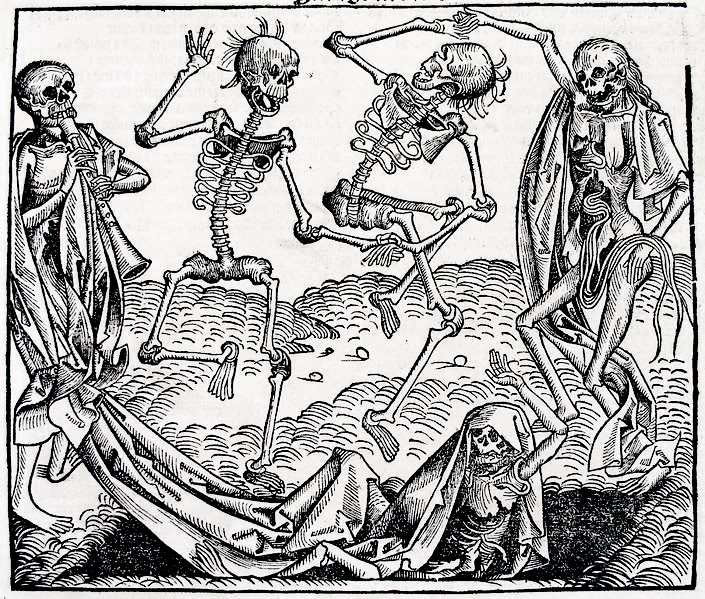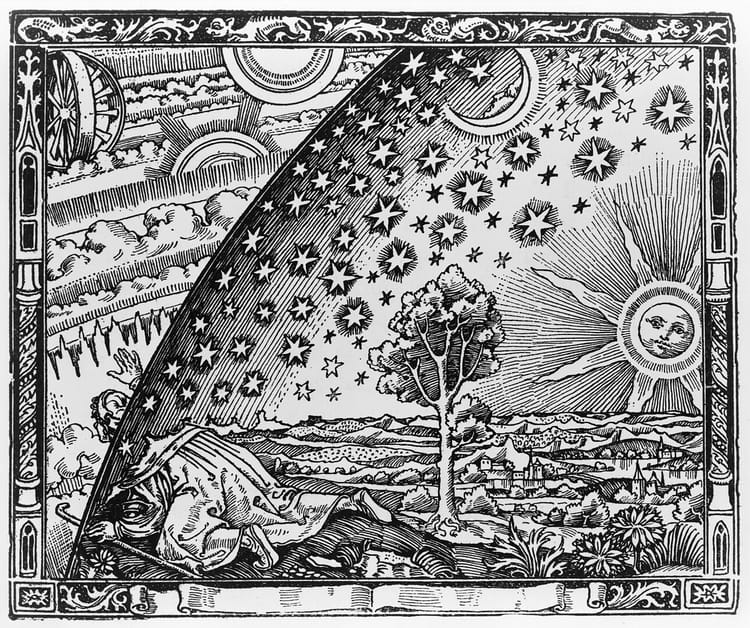New Moon: To be, and not to be

It's Friday. Hello. I have meditations today for New Moon mysteries. They may be rather short, but in this brevity is simplicity, and in this simplicity is the negative space of that which I cannot and should not attempt to put in words.
What is the mystery I'm thinking about? I'm thinking about paradox, not as a challenge to resolve but as a mode of deliberate existence.
A paradox is self-contradiction, a statement that two opposite conditions are both true. Under modern white, colonial-capitalist ideology, paradoxes are the stuff of philosophy, which itself is positioned as a field for "noble" understandings of reality and ethics but not for "practically" governing one's life or society, except in the case of the philosophical schools that echo or prefigure colonial-capitalist socioeconomics already.[1] In that context, paradoxes are particularly trivial bits of entertaining fluff — for teachers to tease pupils with, for clever men to trot out at parties and on dates, for feel-good poetry, or for cloistered mathematicians to try solving in their ivory towers.
Now, I don't use applied (practical) mathematics very effectively, and I hate how most math is taught in US schools, but I actually adore everything I ever grasp of pure mathematics; thus in fairness to those cloistered mathematicians, I will say that their work is not as masturbatory and meaningless as some people might claim. But as for the matter of solving paradoxes, that's what concerns me here. Colonial-capitalism demands rational systems; it demands a scientific method to assign truth-value to contradictory statements such that if one statement is true then the other must be false; it demands that language remain fixed and devoid of nuance.
It takes paradox, slanders it as unnatural, and imposes a series of exclusive "either/or" statements. It breeds inherent hostility in this manner: you are either with us OR you're against us. It speaks to centuries of self-inflicted trauma and deprivation: you can't have your cake and eat it too.
Of course I can have my cake and eat it too. If I eat it, I still have it; it's just inside me now. My digestive system is slowly converting the cake into the components of matter and energy necessary to continue my body's existence. The cake is me and I am the cake. This is a paradox right here — by any pragmatic working definition, I am a human, not a cake, and a cake is not human, and a cake is not me. But in that moment of (un)holy communion, and in the persistence of my body ever since that moment, I am flesh and I am cake and I am every other thing that I've ever devoured. Take of this cake and eat it, for this is my birthday.
I digress. In any case, paradox is not unnatural. It's intrinsic to nature. Most things that we can try to divide along exclusive "either/or" lines are in fact better expressed with the inclusive "and/or." Each thing in reality can be defined by its opposite, but not only is that opposite's presence necessary for forming that definition, in all likelihood it's possible to have circumstances where a thing and its opposite inhabit the exact same space. I've touched on this before with the ecstatic vs. the fertile, but I'm now thinking well beyond that.
The hegemony says that something is either human or animal
But the way of nature is that humans are animals. This does not mean there is no speciation; ordinarily, our bodies are human bodies, and we communicate with human language, and we cannot ask ourselves to act exactly like a fox, nor to ask a fox to act exactly like a human. But there is no special quality of animal-ness setting the fox closer to a spider than to us — as mammalian vertebrates, surely foxes and humans have far more in common with each other than with spiders.
And in ritual space, ordinary considerations dissolve. We may feel ourselves as foxes, and we may listen to foxes speak. Indigenous art and folklore, both ancient and modern, makes a place for skinchangers, or for beings with animal heads on human bodies or the reverse. Perhaps, if foxes ever hold their own inscrutable rites, they too see themselves becoming humans, or spiders, or fish, or trees.
The hegemony says that a human is either male or female
But the way of nature is that humans are aggregations of endless traits that can be called male, female, neither, or something else entirely. No fixed truth resides in our chromosomes, for these do not always align with our anatomy. No fixed truth resides in our anatomy, for this is a spectrum, and even beyond "ambiguous" examples (ambiguity implying there are two firm points to choose between) there are XX-chromosomal, uterus/ovary/vagina-possessing, female-assigned-at-birth, self-identified women who grow beards and experience few periods in conditions like polycystic ovary syndrome; there are XY-chromosomal, testicle/penis-possessing, male-assigned-at-birth, self-identified men who still grow breasts, whether due to high estrogen or low androgens. By and large, aside from deliberately pejorative contexts, a cis woman who cannot conceive a child, or who loses her breasts (or barely develops any), is still called a woman even though she doesn't do what women are "meant" to do and doesn't look how women are "meant" to look; a cis man who cannot get an erection, or who is castrated completely, is still called a man even though he doesn't experience what "all men" are imagined to experience. In private medical contexts, distinguishing biological sexual characteristics can be meaningful and necessary, but they are merely characteristics, not categories.
All of this is to say nothing of the myriad social gender traits — roles, presentations, behaviors — that constitute how we distinguish ourselves in public. But I think that even in contemporary Western-style communities of people who consider themselves feminists, trans liberationists, gender rebels, and more, there's a frequent temptation to fall back on the notion that "sex is between your legs, gender is between your ears." To me, it's necessary to question either/or binarism within sex itself, not just because such binarism overlooks intersex people, but because the people who want to repress, jail, beat up, and kill trans people really do not care about whether anyone's gender expression is female, male, femme, butch, nonbinary, third gender, neutrois, or insert-other-term-here. The people who want to disappear us are only interested in the fact that whatever we are wearing or doing or saying we identify as, it's "in defiance" of the sex category we were placed in when we were born.
Those categories themselves do not exist. They literally are imaginary.
As with the human vs. the animal, indigenous traditions of the past and present once again know better. In ritual space, practical reasons to distinguish sexual anatomy also dissolve. There are magical sex changes, there are hermaphroditic figures, there are figures with impossibly large cocks, impossibly gaping cunts. The old gods are queer, exaggerated, mercurial, even when they aren't Mercury.
The hegemony says that up is up, and down is down
But the way of nature is as of above, so below. This manifests as more than small, microcosmic structures mirroring larger, macrocosmic equivalents. Rather, there's a mirroring across opposing planes of equal scope.
In sexual union, to take applies both to the penetrator and the enveloper, as does to give.
In consensual love and power exchange we are bound through attachment and negotiation, and in this very bondage there is more freedom than without it.
We may distinguish between the body and the mind, between material and psychic states, but this is purely an experiential differentiation. There is no real barrier between these two modes — and it's not that the mind is merely an illusory outgrowth of the body, nor that the body is a hallucination of the mind, but rather that mind is body and body is mind.
In many if not most cultures, the dead are buried; and prior to any cultural considerations, when something dies it generally falls on the ground and decomposes there, even in the sea where it sinks to the ocean floor. Thus the earth is where the dead rest. But ritually speaking, the dead rest as much in the sky as they do in the ground; this is not only the case with Christian concepts of heaven, but with many much older animist frameworks worldwide. To pass into the chthonic realm is to pass into the celestial realm. Lakes are magic places because they are ground-level mirrors of the sky. Mirrors as a whole are magic because they show an inverted yet otherwise identical reality — a chiral reality.
In the Cymric (Welsh) animism of my ancestors, the Otherworld is where the dead dwell, so it exists underneath our feet; it is Annwn, likely from the early Gallo-Brittonic *andedubnos[2], "under-world." But the dwelling place of Arawn, lord of Annwn, is simultaneously Caer Sidi, "revolving fortress," a tower of glass ever-spinning, suggestive of the zodiac turning along the ecliptic. So the Otherworld may also be above us in the night sky. And in this tension between above and below, its gateways open in neither direction — as we step sideways into not-here.
Even scientifically, "up" and "down" are merely functions of gravity. They are relative to whatever gravitational body is exerting influence. As the universe continues to expand, everything is constantly moving "up." But as residents of a single planet, we can never move "up" without eventually moving "down."
The hegemony requires solid essence over fluid existence
To insist on the resolution of paradoxes is to insist on a constant grammar of the cosmos, and a constant lexicon, the Logos, the word of god. But this imposes order where order cannot be made. Whatever order does arise within nature is order birthed from ever-present chaos. Nothing is ever any one thing. There is no singular essence, no platonic form, no real identity.
There is no "is."
Existentialism, at least as elaborated by one of my favorite worthwhile philosophers (Sartre), recognizes that before anything can be described as "being" anything, it is only the raw potential to be something, a void lacking exact form. This applies especially to conscious things, which have the power to define themselves but likewise the power to deliberately change those definitions. Truth, real truth, is silence. Languages are elaborate lies.
And so I can say that I "am" whatever I want to say I am. This is a lie if I don't really mean it — if I'm being insincere. But it's also a lie even if I'm altogether sincere — because whatever I've said I am, I'm not ever reductively, completely, identically, permanently that thing. To pretend otherwise is to engage in uncritical performance; it is not authentic living. The wellness industry is obsessed with authenticity but is far too performative to actually be authentic.
You cannot be anything authentically.
You can only do.
Hence the magic significance of fairy lands, highlighting the awesome power of things becoming what they are not. Hence the spectacular and transformative terror of meeting one's doppelgänger: for in the mundane you imagine that you are yourself, of course, what else could you be? And here comes something that is not you, but is you.
And hence the lessons of ritual living, of recovering animist thought.
Ritual, liminal, fairy
In ritual space, with or without entheogenic assistance, ideally we enter a flow state where doing is all, and being is not. We un-are. Our existence persists but we are driven to perform action, not to remain in stasis.
This helps to open up a liminal sense of the world around us in turn. Liminal spaces — thresholds, waypoints, in-between or temporary environments — are often framed as eerie or unsettling. Consider all the superstitions about doorways and crossroads, or all the strange feelings we get at gas stations, hotels, airports, and waiting rooms. Consider how our eyes play the most tricks on us during dawn and dusk, when it is neither night nor day and our retinas are poorly adapted to perceiving things accurately because neither our color vision nor our monochrome vision is altogether reliable. Consider all the horror stories set in those locations, at those times — or at midnight, when in conventional Western timekeeping it's both the end of one day and the start of another. And yes, in many ways liminality and its embedded paradoxes are inherently frightening.
But this is also where the veil is opened. This is what stepping sideways into fairy is about. As I said above, lakes are magic; they are liminal. So too is the mouth of a cave, the threshold of the earth's bowels. So too is the flickering of fire, which is visible yet invisible. So too is a night lit by the Full Moon, darker than day yet brighter than true darkness. So too are times of year when the seasons change; it's this very change that makes the veil thinner.
I think of these things in choosing to let paradoxes be what they are. A mystery must not go answered, or it is no longer mysterious. In the coming times, O, let us stop answering so much, and let us learn again to consider wonder as sheer wonder.
[1] That is, in this ideology it's all well and good to imagine and debate concepts of human rights and ecological sustainability, but when it comes to operating in "the real world," the arbiters of hard, concrete truth will insist that some humans just can't have as many rights as others, and some oil spills just have to be risked.
[2] For the linguistically non-initiated, a * before an ancient word means that it is not a documented, real word, but a word that linguists have (to the best of their ability) extrapolated as having probably once been real.
Thank you so much for reading. I welcome and would in fact love comments from others on this post; upgrading your free subscription to a paid one (starting at just $1/month) would also be welcome so that one day I can break even on the cost of sending this out each week. But in the meantime, enjoy this New Moon, and next week there will be a second New Moon post for paid subscribers in the form of this season's spotlight on the Devil (and sex, and gender, and sex, and lots of sex). After that, I'll be looking at my growing relationship with fiber arts.





Member discussion